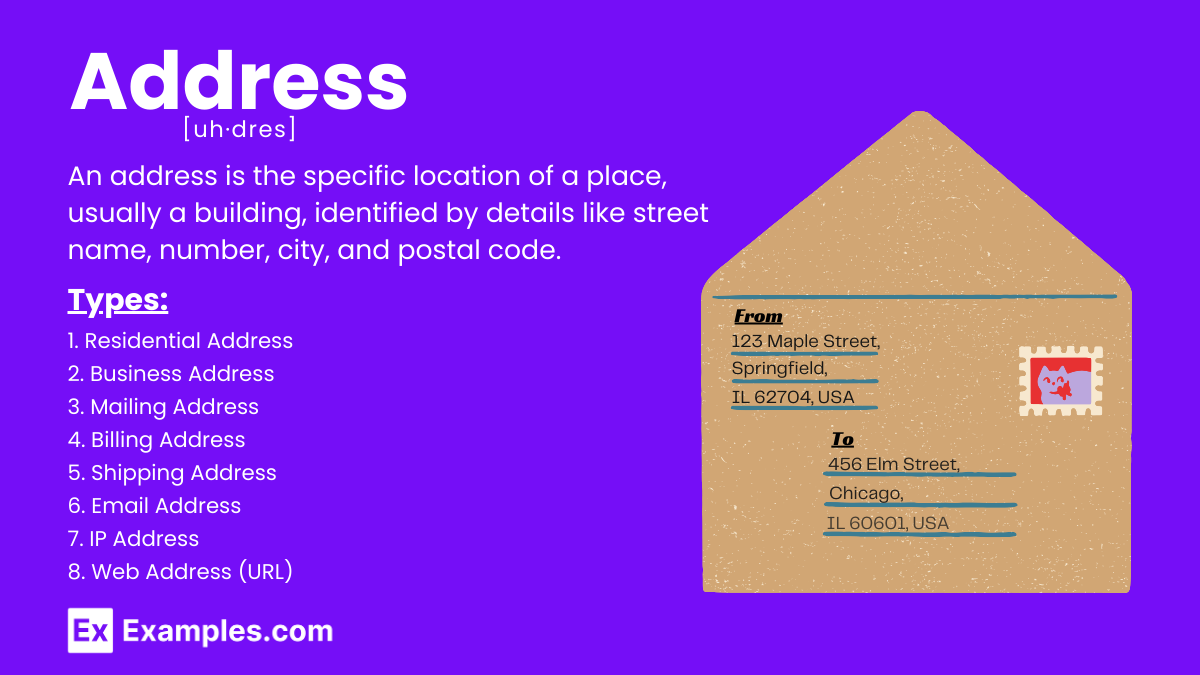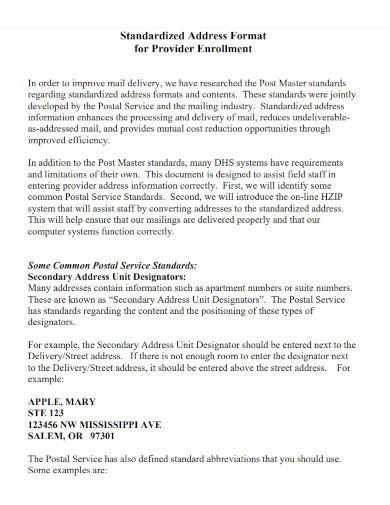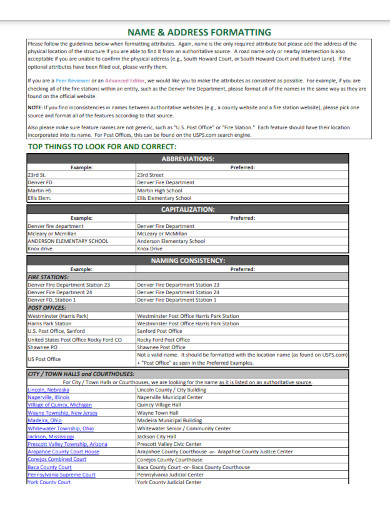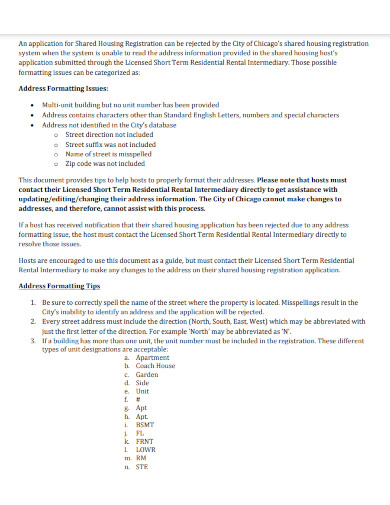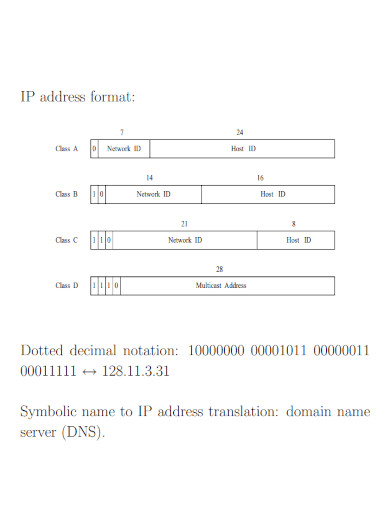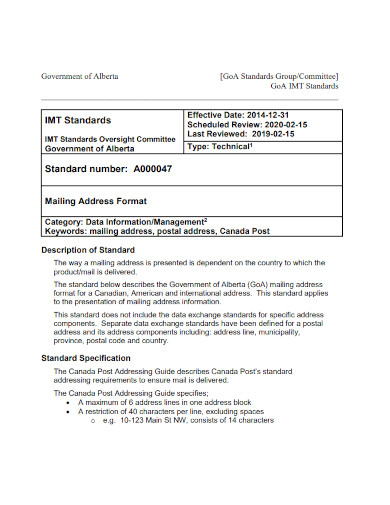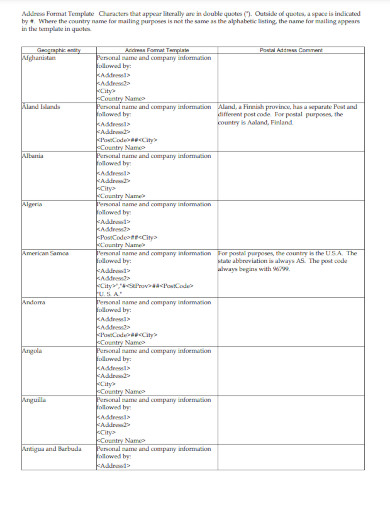45+ Address Examples
When a person needs to send a letter or an object to someone they love and care about, they will need to write down the location of the receiver. The location needs to be succinctly and concisely written down for the success of the whole sending process. This is why people need to learn how to properly write down the addresses themselves and other people.
What Is an Address?
The word address can mean a couple of things, which are dependent on the direction of the conversation, books like biographies and autobiographies, quantitative and qualitative research articles, and journal articles. The first meaning an address can take refers to a specific geographical location. The word address can also be an action a person can do in assertive communication.
Types of Addresses
Addresses can be categorized based on their purpose and the type of location they refer to. Here are the main types:
1. Residential Address
- Description: A location where a person or family lives.
- Example: 789 Oak Avenue, Houston, TX 77002, USA
2. Business Address
- Description: The location of a company or organization.
- Example: 101 Corporate Plaza, Suite 300, Dallas, TX 75201, USA
3. Mailing Address
- Description: A location used for receiving mail, which may differ from the physical address.
- Example: P.O. Box 1234, New York, NY 10001, USA
4. Billing Address
- Description: The address associated with a credit card or billing information.
- Example: 555 Credit Lane, Miami, FL 33101, USA
5. Shipping Address
- Description: The location where goods are delivered.
- Example: 321 Delivery Road, San Francisco, CA 94103, USA
6. Email Address
- Description: An electronic address used for sending and receiving emails.
- Example: example@domain.com
7. IP Address
- Description: A unique string of numbers identifying a device on a network.
- Example: 192.168.1.1
8. Web Address (URL)
- Description: The address of a web page on the internet.
- Example: www.examples.com
Address Formats
1. United States Address Format
Example:
John Doe
1234 Main Street
Apartment 56B
Springfield, IL 62704
USA
Components:
- Recipient’s Name: Full name of the recipient.
- Street Address: House number, street name, and apartment or unit number.
- City, State, and ZIP Code: City name, state abbreviation, and ZIP Code.
- Country: “USA”
2. United Kingdom Address Format
Example:
Mrs. Jane Smith
10 Downing Street
London
SW1A 2AA
United Kingdom
Components:
- Recipient’s Name: Full name with titles if applicable.
- Street Address: House number and street name.
- City or Town: City or town name.
- Postal Code: Postcode.
- Country: “United Kingdom”
3. Canadian Address Format
Example:
Mr. John Doe
123 Maple Street
Ottawa, ON K1A 0B1
Canada
Components:
- Recipient’s Name: Full name of the recipient.
- Street Address: House number and street name.
- City, Province, and Postal Code: City name, province abbreviation, and postal code.
- Country: “Canada”
4. Australian Address Format
Example:
Ms. Emma Brown
50 George Street
Sydney NSW 2000
Australia
Components:
- Recipient’s Name: Full name of the recipient.
- Street Address: House number and street name.
- City, State, and Postal Code: City name, state abbreviation, and postal code.
- Country: “Australia”
5. Japanese Address Format
Example:
山田 太郎
〒100-0001
東京都千代田区千代田1-1
日本
Components:
- Recipient’s Name: Full name (in Japanese characters for domestic mail).
- Postal Code: Postal code preceded by the symbol 〒.
- Prefecture, City, and District: Prefecture, city, and district names.
- Street Address and Building Number: Detailed street address and building number.
- Country: “Japan” (use 日本 for domestic mail)
6. Indian Address Format
Example:
Mr. Rajesh Kumar
1234 MG Road
Near Central Park
Bengaluru, Karnataka 560001
India
Components:
- Recipient’s Name: The first line should include the full name of the person or entity.
- Street Address: The second line should have the house/building number followed by the street name.
- Landmark (if applicable): The third line can include a well-known landmark to help with locating the address.
- City, State, and PIN Code: The fourth line should list the city name, state name, and PIN Code (Postal Index Number).
- Country: The final line should include the country name.
Examples for Address
Examples of Gmail Address
When creating a Gmail address, it’s important to choose a format that is easy to remember and professional, especially for business or educational purposes. Here are some common formats with examples:
1. Standard Personal Format
Example:
- FirstNameLastName: johnsmith@gmail.com
- FirstName.LastName: john.smith@gmail.com
- FirstNameInitialLastName: jsmith@gmail.com
- FirstName.LastNameInitial: john.s@gmail.com
2. Professional Format
Example:
- FirstName.MiddleInitial.LastName: john.m.smith@gmail.com
- FirstNameLastName.Company: johnsmith.company@gmail.com
- FirstName_LastName: john_smith@gmail.com
- FirstNameLastNameYear: johnsmith1980@gmail.com
3. Educational Format
Example:
- FirstNameLastName.School: johnsmith.university@gmail.com
- FirstName.LastName.ClassYear: john.smith.2024@gmail.com
- FirstNameLastName.Subject: johnsmith.math@gmail.com
- FirstInitialLastName.School: jsmith.schoolname@gmail.com
4. Creative Format
Example:
- Nickname.LastName: johnny.smith@gmail.com
- FirstNameHobby: johnphotography@gmail.com
- FirstNameLastName.FavoriteNumber: johnsmith42@gmail.com
- FirstNameLastNameLocation: johnsmith.nyc@gmail.com
5. Business Format
Example:
- FirstNameLastName.Business: johnsmith.consulting@gmail.com
- FirstNameLastName.Profession: johnsmith.designer@gmail.com
- FirstName.Company: john.company@gmail.com
- FirstNameLastName.Role: johnsmith.ceo@gmail.com
Examples of Business Address
A properly formatted business address ensures effective communication and mail delivery. Here are examples of different types of business addresses.
1. Standard Business Address
Example:
ABC Corporation
1234 Market Street
Suite 400
San Francisco, CA 94103
USA
Components:
- Company Name: The first line includes the company name.
- Street Address: The second line has the street address with building number and street name.
- Suite Number: The third line specifies the suite or office number.
- City, State, and ZIP Code: The fourth line lists the city, state abbreviation, and ZIP Code.
- Country: The final line includes the country name.
2. Head Office Address
Example:
XYZ Enterprises
7890 Corporate Blvd.
Head Office
Chicago, IL 60601
USA
Components:
- Company Name: The first line includes the company name.
- Street Address: The second line has the street address.
- Department/Office: The third line specifies the head office.
- City, State, and ZIP Code: The fourth line lists the city, state abbreviation, and ZIP Code.
- Country: The final line includes the country name.
3. Branch Office Address
Example:
Tech Innovations Inc.
456 Elm Street
Branch Office
Austin, TX 78701
USA
Components:
- Company Name: The first line includes the company name.
- Street Address: The second line has the street address.
- Department/Office: The third line specifies the branch office.
- City, State, and ZIP Code: The fourth line lists the city, state abbreviation, and ZIP Code.
- Country: The final line includes the country name.
4. Business Address with PO Box
Example:
Global Solutions LLC
P.O. Box 12345
Denver, CO 80202
USA
Components:
- Company Name: The first line includes the company name.
- P.O. Box Number: The second line specifies the P.O. Box number.
- City, State, and ZIP Code: The third line lists the city, state abbreviation, and ZIP Code.
- Country: The final line includes the country name.
5. International Business Address
Example:
Innovatech GmbH
Musterstraße 1
10115 Berlin
Germany
Components:
- Company Name: The first line includes the company name.
- Street Address: The second line has the street address.
- Postal Code and City: The third line lists the postal code and city name.
- Country: The final line includes the country name.
6. Department Specific Address
Example:
HealthCare Corp.
Attn: Billing Department
987 Wellness Drive
Los Angeles, CA 90017
USA
Components:
- Company Name: The first line includes the company name.
- Attention Line: The second line specifies the department.
- Street Address: The third line has the street address.
- City, State, and ZIP Code: The fourth line lists the city, state abbreviation, and ZIP Code.
- Country: The final line includes the country name.
7. Warehouse Address
Example:
Logistics Solutions
Warehouse #5
204 Industrial Park
Newark, NJ 07102
USA
Components:
- Company Name: The first line includes the company name.
- Warehouse Number: The second line specifies the warehouse number.
- Street Address: The third line has the street address.
- City, State, and ZIP Code: The fourth line lists the city, state abbreviation, and ZIP Code.
- Country: The final line includes the country name.
8. Business Park Address
Example:
Tech Park Innovations
Building 6, Tech Park
88 Silicon Valley Way
San Jose, CA 95110
USA
Components:
- Company Name: The first line includes the company name.
- Building Number: The second line specifies the building number and park name.
- Street Address: The third line has the street address.
- City, State, and ZIP Code: The fourth line lists the city, state abbreviation, and ZIP Code.
- Country: The final line includes the country name.
9. Small Business Address
Example:
Green Leaf Cafe
123 Downtown Road
Suite 2
Portland, OR 97204
USA
Components:
- Company Name: The first line includes the company name.
- Street Address: The second line has the street address.
- Suite Number: The third line specifies the suite number.
- City, State, and ZIP Code: The fourth line lists the city, state abbreviation, and ZIP Code.
- Country: The final line includes the country name.
10. Corporate Office Address
Example:
MegaCorp International
Corporate Office
555 Corporate Drive
Atlanta, GA 30303
USA
Components:
- Company Name: The first line includes the company name.
- Office Type: The second line specifies the corporate office.
- Street Address: The third line has the street address.
- City, State, and ZIP Code: The fourth line lists the city, state abbreviation, and ZIP Code.
- Country: The final line includes the country name.
Examples of Residential Address
Residential addresses vary based on location, but they generally follow a standard format to ensure accurate mail delivery. Here are some examples:
1. United States Residential Address
Example:
Mr. John Smith
1234 Oak Street
Apt. 56B
Springfield, IL 62704
USA
Components:
- Recipient’s Name: Full name of the resident.
- Street Address: House number and street name.
- Apartment/Suite Number: Apartment or unit number if applicable.
- City, State, and ZIP Code: City name, state abbreviation, and ZIP Code.
- Country: “USA” (for international mail).
2. United Kingdom Residential Address
Example:
Mrs. Jane Doe
10 Downing Street
Flat 3B
London
SW1A 2AA
United Kingdom
Components:
- Recipient’s Name: Full name with titles if applicable.
- Street Address: House number and street name.
- Apartment/Flat Number: Apartment or flat number if applicable.
- City or Town: City or town name.
- Postal Code: Postcode.
- Country: “United Kingdom”.
3. Canadian Residential Address
Example:
Mr. Michael Johnson
123 Maple Street
Apt. 2
Ottawa, ON K1A 0B1
Canada
Components:
- Recipient’s Name: Full name of the resident.
- Street Address: House number and street name.
- Apartment/Suite Number: Apartment or unit number if applicable.
- City, Province, and Postal Code: City name, province abbreviation, and postal code.
- Country: “Canada”.
4. Australian Residential Address
Example:
Ms. Emma Brown
50 George Street
Unit 12
Sydney NSW 2000
Australia
Components:
- Recipient’s Name: Full name of the resident.
- Street Address: House number and street name.
- Apartment/Unit Number: Apartment or unit number if applicable.
- City, State, and Postal Code: City name, state abbreviation, and postal code.
- Country: “Australia”.
5. Indian Residential Address
Example:
Mr. Rajesh Kumar
1234 MG Road
Near Central Park
Bengaluru, Karnataka 560001
India
Components:
- Recipient’s Name: Full name of the resident.
- Street Address: House number and street name.
- Landmark (if applicable): Nearby landmark for better location identification.
- City, State, and PIN Code: City name, state name, and PIN Code (Postal Index Number).
- Country: “India”.
6. Japanese Residential Address
Example:
山田 太郎
〒100-0001
東京都千代田区千代田1-1
日本
Components:
- Recipient’s Name: Full name in Japanese characters.
- Postal Code: Postal code preceded by the symbol 〒.
- Prefecture, City, and District: Prefecture, city, and district names.
- Street Address and Building Number: Detailed street address and building number.
- Country: “日本” (Japan).
7. German Residential Address
Example:
Herr Max Müller
Musterstraße 1
10115 Berlin
Germany
Components:
- Recipient’s Name: Full name with appropriate title (Herr/Frau).
- Street Address: Street name and house number.
- Postal Code and City: Postal code and city name.
- Country: “Germany”.
8. French Residential Address
Example:
Mme. Marie Dupont
123 Rue de Rivoli
75001 Paris
France
Components:
- Recipient’s Name: Full name with appropriate title (M./Mme.).
- Street Address: Street name and house number.
- Postal Code and City: Postal code and city name.
- Country: “France”.
9. Italian Residential Address
Example:
Signor Luca Rossi
Via Roma 123
00184 Roma RM
Italy
Components:
- Recipient’s Name: Full name with appropriate title (Signor/Signora).
- Street Address: Street name and house number.
- Postal Code, City, and Province: Postal code, city name, and province abbreviation.
- Country: “Italy”.
10. Brazilian Residential Address
Example:
Sr. João Silva
Rua das Flores, 789
Apartamento 101
São Paulo, SP 01000-000
Brazil
Components:
- Recipient’s Name: Full name with appropriate title (Sr./Sra.).
- Street Address: Street name and house number.
- Apartment Number: Apartment number if applicable.
- City, State, and Postal Code: City name, state abbreviation, and postal code.
- Country: “Brazil”.
Examples of Website Address
A website address, also known as a URL (Uniform Resource Locator), is the address of a resource on the internet. Here are examples of website addresses across various categories:
1. Commercial Website
Example:
Amazon: https://www.amazon.com
- Components:
- https: Protocol (Hypertext Transfer Protocol Secure)
- www: World Wide Web prefix
- amazon: Domain name
- .com: Top-level domain (TLD)
2. Educational Website
Example:
Harvard University: https://www.harvard.edu
- Components:
- https: Protocol
- www: World Wide Web prefix
- harvard: Domain name
- .edu: Top-level domain for educational institutions
3. Government Website
Example:
U.S. Government: https://www.usa.gov
- Components:
- https: Protocol
- www: World Wide Web prefix
- usa: Domain name
- .gov: Top-level domain for government entities
4. Non-Profit Organization Website
Example:
World Wildlife Fund: https://www.worldwildlife.org
- Components:
- https: Protocol
- www: World Wide Web prefix
- worldwildlife: Domain name
- .org: Top-level domain for non-profit organizations
5. Personal Blog
Example:
John’s Blog: https://www.johnsblog.com
- Components:
- https: Protocol
- www: World Wide Web prefix
- johnsblog: Domain name
- .com: Top-level domain
6. News Website
Example:
BBC News: https://www.bbc.com/news
- Components:
- https: Protocol
- www: World Wide Web prefix
- bbc: Domain name
- .com: Top-level domain
- /news: Path to a specific section of the website
7. E-commerce Website
Example:
Etsy: https://www.etsy.com
- Components:
- https: Protocol
- www: World Wide Web prefix
- etsy: Domain name
- .com: Top-level domain
8. Social Media Website
Example:
Facebook: https://www.facebook.com
- Components:
- https: Protocol
- www: World Wide Web prefix
- facebook: Domain name
- .com: Top-level domain
9. Entertainment Website
Example:
Netflix: https://www.netflix.com
- Components:
- https: Protocol
- www: World Wide Web prefix
- netflix: Domain name
- .com: Top-level domain
10. Tech Company Website
Example:
Google: https://www.google.com
- Components:
- https: Protocol
- www: World Wide Web prefix
- google: Domain name
- .com: Top-level domain
Proof of Address Examples
Proof of address documents are required in various situations, such as opening a bank account, applying for a job, or verifying your identity for government services. These documents must clearly show your name and residential address. Here are examples of common documents that can serve as proof of address:
1. Utility Bill
Example:
Electricity Bill
Power Company Inc.
123 Energy Drive
Springfield, IL 62704
USABill To:
Mr. John Smith
1234 Oak Street
Apt. 56B
Springfield, IL 62704
USA
- Utility Bills: Electricity, water, gas, or internet bills are widely accepted.
- Components: The document must display your name, address, and the utility company’s information.
2. Bank Statement
Example:
Bank Statement
First National Bank
456 Financial Blvd.
New York, NY 10001
USAAccount Holder:
Mrs. Jane Doe
10 Downing Street
Flat 3B
London
SW1A 2AA
United Kingdom
- Bank Statements: Statements from your bank account showing your name and address.
- Components: Should include your full name, residential address, and the bank’s information.
3. Lease Agreement
Example:
Residential Lease Agreement
Landlord: ABC Realty
Landlord Address: 789 Realty Lane, San Francisco, CA 94103, USATenant: Mr. Michael Johnson
Tenant Address: 123 Maple Street, Apt. 2, Ottawa, ON K1A 0B1, Canada
- Lease Agreements: Rental agreements or contracts showing your name and address.
- Components: Should clearly state the property address, your name, and the landlord’s details.
4. Government-Issued ID
Example:
Driver’s License
State of California
Department of Motor VehiclesLicense Holder:
Name: Emma Brown
Address: 50 George Street, Unit 12, Sydney NSW 2000, Australia
- Driver’s License: An ID that often includes your residential address.
- Components: Must show your name, photo, and address.
5. Insurance Policy Statement
Example:
Home Insurance Policy
Insurance Co.
1234 Policy St.
Chicago, IL 60601
USAInsured:
Mr. Rajesh Kumar
1234 MG Road
Near Central Park
Bengaluru, Karnataka 560001
India
- Insurance Documents: Home or auto insurance policies showing your address.
- Components: Your name, address, and policy details.
6. Mortgage Statement
Example:
Mortgage Statement
Lending Bank
123 Mortgage Ave.
Austin, TX 78701
USABorrower:
Ms. Maria Rodriguez
Calle Mayor, 45
28013 Madrid
Spain
- Mortgage Statements: Monthly or annual mortgage statements showing your address.
- Components: Your name, address, and mortgage details.
7. Voter Registration Card
Example:
Voter Registration Card
Election Commission
123 Democracy Blvd.
Atlanta, GA 30303
USARegistered Voter:
Name: John Doe
Address: 456 Elm Street, Branch Office, Austin, TX 78701, USA
- Voter Registration Cards: Official cards that show your registered address.
- Components: Your name and residential address.
8. Recent Pay Stub
Example:
Pay Stub
Employer: XYZ Enterprises
1234 Employment St.
Los Angeles, CA 90017
USAEmployee:
Mr. Amit Sharma
7890 Commerce Blvd., Suite 400, Los Angeles, CA 90017, USA
- Pay Stubs: Employment documents showing your address.
- Components: Should include your name, address, and employer’s information.
9. Tax Return Document
Example:
Tax Return
Internal Revenue Service
1234 Taxpayer Rd.
Washington, DC 20001
USATaxpayer:
Ms. Emily Wilson
123 Broadway Ave., New York, NY 10001, USA
- Tax Documents: Federal or state tax returns showing your address.
- Components: Your name, address, and tax details.
10. Medical Bill
Example:
Medical Bill
Healthcare Provider: City Hospital
123 Wellness Way
Miami, FL 33101
USAPatient:
Mr. Andrew White
555 Health Blvd., Miami, FL 33101, USA
- Medical Bills: Bills from hospitals or clinics showing your address.
- Components: Your name, address, and healthcare provider’s information.
More Examples & Formats for Address in PDF
1. Standardized Address Format for Provider Enrollment
2. Name and Address Fomatting
3. Shared Housing Address Formatting Guide
4. IP Address Format
5. Mailing Address Format
6. Address Format Template
Synonym & Antonyms for Address
| Synonyms | Antonyms |
|---|---|
| Speech | Silence |
| Talk | Ignore |
| Lecture | Disregard |
| Presentation | Neglect |
| Residence | Homelessness |
| Location | Displace |
| Destination | Departure |
| Place | Move away |
| Site | Evacuate |
| Venue | Remove |
How to Write Your Address
The person’s address relates to the exact geographical location the person is living or staying in. This means that you will need to know how to properly write down your address and other people’s addresses. If you need a reference you may use any of the address formats, examples, and samples on the list above.
Step 1: Select and Outlining the Type of Address You Are Referring To
Begin by selecting and outlining the type of address you are going to write or use. This step is very important as each type of address has its format and usage. Improper writing of the address may lead to miscommunication and problems in the future.
Step 2A: If the Address is International, Write the Address in the International Format
If the address you want to write down is international, then it should follow the international address format. Begin by writing down the building number, the street name, and (optional) the name of the house on the first line. On the second line, write down the city name and the country the city is in. The address should be closed off on the third line with the zip code of the area.
Step 2B: If the Address is a Military Address, Write the Address Using the Military Address Format
If the address you are using is a military address, then you will need to use the military address format. Start by writing the name of the person and the building number on the first line of the address. This should be followed on the second line by either of these abbreviations: DPO (Diplomatic Post Office), FPO (Fleet Post Office), or APO (Air or Army Post Office). The third line should also have the specific abbreviation that refers to the person’s station, these abbreviations are AA (Armed Forces of America), AE (Armed Forces of Europe), and AP (Armed Forces of the Pacific). The zip code will follow the final part of this address.
Step 2C: If the Address is Local, Write the Address Using the Standard Format
If the address you are using is local, then you will write the said address in the standard format. The first line should be the building number and the street address. This will be followed by the final line, which will contain the city name, state, and zip code.
What is a postal address?
A postal address is the address where mail or packages are delivered, including recipient’s name, street address, city, state, ZIP code, and country.
How do I format a U.S. address?
Include the recipient’s name, street address, apartment number (if applicable), city, state abbreviation, ZIP code, and country (if international).
What is the difference between a mailing address and a residential address?
A mailing address is where you receive mail; it can be different from a residential address, which is where you live.
How do I write an international address?
Include the recipient’s name, street address, city, postal code, and country. Follow the destination country’s specific address format.
What does “c/o” mean in an address?
“c/o” stands for “care of.” Use it when sending mail to someone at another person’s address, indicating the person who will receive it.
Can a P.O. Box be a legal address?
A P.O. Box can be a mailing address, but not a legal address for residency verification. Legal addresses usually require a physical location.
What is a ZIP Code?
A ZIP Code is a postal code used by the United States Postal Service to identify specific geographic regions for mail delivery.
How do I format an address for an apartment?
Include the recipient’s name, street address, apartment number, city, state, and ZIP code. Example: Jane Doe, 1234 Elm St, Apt 56B, Springfield, IL 62704.
Why is my mail not being delivered?
Possible reasons include incorrect address format, outdated address, postal service issues, or the recipient has moved without updating their address.
How do I update my address with USPS?
Visit the USPS website or your local post office to fill out a change of address form, ensuring your mail is forwarded to your new address.



